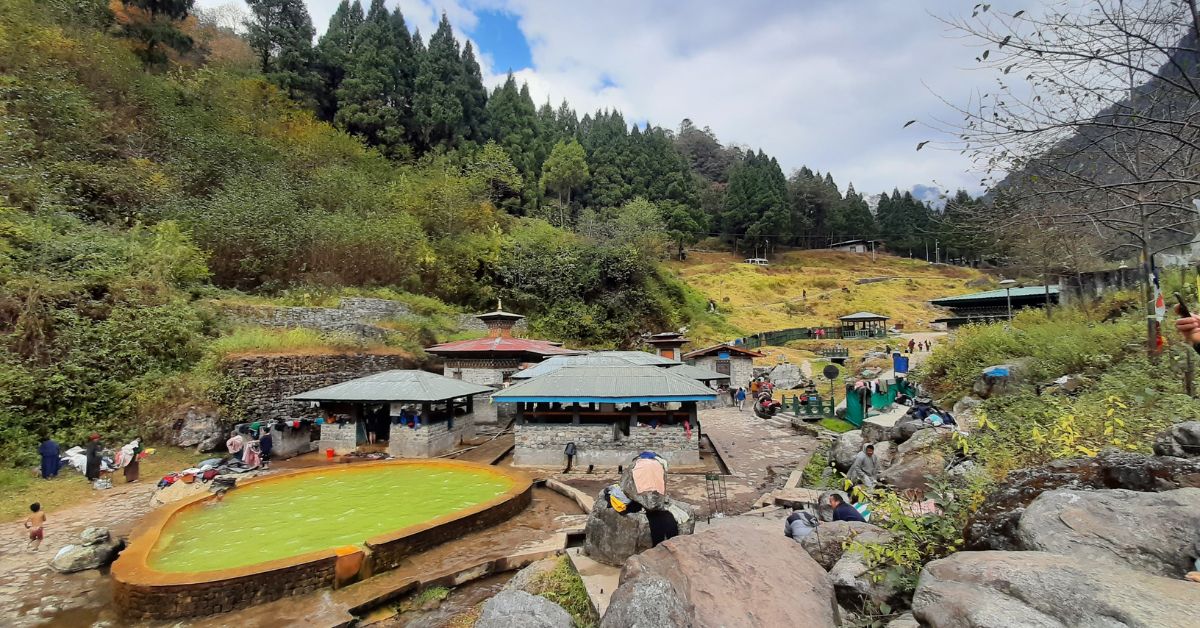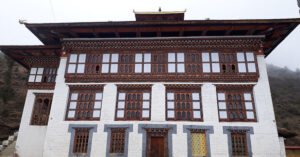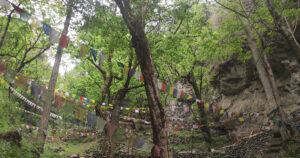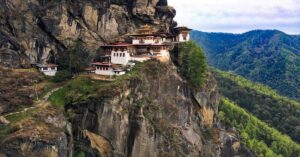Hot springs or Tshachu are natural springs of geothermally heated groundwater that emerge onto the Earth’s surface. They are formed when water is heated by shallow bodies of magma or by circulation through faults to hot rock deep in the Earth’s crust.
The origin of hot springs in Bhutan dates back to the visit of Guru Rinpoche to Bhutan in 746 AD. Because of this, Tshachus are revered and regarded as holy, and as a result, Tshachus are typically located in sacred places.
In Bhutan, a hot spring is called a Tshachu. Bhutan has 10 hot springs (Tshachu), 17 medicinal water or mineral springs (Menchu), and 17 holy spring waters (Drupchhu). The hot springs are regarded as the spiritually most popular spring waters.
The most popular hot springs in Bhutan are the Chuboog Tshachu and Koma Tshachu in Punakha; the Duenmang Tshachu in Zhemgang; the Khempajong Nye Tshachu in Lhuntse; the Gasa Tshachu in Gasa; and the Gelephu Tshachu in Sarpang.
Bhutanese have used Tshachu for generations for relaxation, bathing, and treating various physical illnesses. The traditional winter custom of visiting Tshachu reflects how seriously the Bhutanese people take their therapeutic practices.
Also Read: Guru Rinpoche in Bhutan: His Visits to Bhutan and Sacred Sites
Bhutanese Beliefs on Hot Spring or Tshachu
The hot springs (Tshachu) are said to have been created by Lord Buddha and Bodhisattvas. The origin of Tshachu is also attributed to Guru Rimpoche’s visit to Bhutan. For the Bhutanese people, these holy water sources, which are found in sacred locations, are immensely significant.
Bhutanese believe that Tshachu can cure all diseases. According to another legend, if a person enters the Tsachu just once in their lifetime, they will not experience rebirth in the three worlds of ” hell (Ngelwa), hungry ghosts (Yidag), or animals (Duedhro)”.
Hot Springs in Bhutan
- Chubu Tshachu
- Dhur Tshachu
- Duenmang Tshachu
- Gasa Tshachu
- Gayza Tshachu
- Gelephu Tshachu
- Khambalung Ney Tshachu
- Koma Tshachu
- Pasalum Tshachu
- Yoenten KuenjungTshachu
Types of Natural Hot Springs
There are two kinds of hot springs: natural and artificial.
Depending on the mineral composition, natural hot springs are further divided into five categories:
- Hot spring rich in coal and sodium carbonate,
- Hot spring rich in coal and sulfur,
- Hot spring rich in coal and mineral pitch,
- Hot spring rich in coal, sodium carbonate, and sulfur, and
- Hot spring rich in coal, sulfur, mineral pitch, and realgar.
Moreover, hot springs can be divided into five categories based on the minerals they contain:
- Hot Spring rich in sulfur nativum,
- Hot Spring rich in sulfur,
- Hot Spring rich in lime,
- Water percolating from rocks,
- Hot springs rich in calcite or carbonate minerals.
Tshachu can also be divided into 101 varieties based on the mix of various minerals.
Chemical Compositions of Hot Springs or Tshachu
Bhutan’s hot springs are abundant in limestone, sodium carbonate, sulfur, mineral pitch, and coal, which come in various colors, including light blue, blue-black, and white. However, there haven’t been any scientific geochemical investigations to estimate their mineral concentration.
Also Read: Chemical Compositions of Menchhu or Medicinal (mineral) Springs in Bhutan
Ethnopharmacological Benefits of Hot Spring or Tshachu
Bathing in Tshachu directly helps the skin absorb minerals like calcium, sulfur, iron, magnesium, potassium, silicon dioxide, salt, and fluorine. This can help heal skin diseases, including psoriasis and atopic dermatitis. Sulfurous mineral waters have long been utilized in medical hydrology to cure a variety of ailments. In recent years, sulfurous mineral waters and sulfurous muds have been applied topically to treat rheumatoid arthritis, osteoarthritis in the hands and knees, skin disorders, chronic inflammatory diseases, and anxiety in cancer patients nearing the end of their lives.
Benefits of Tshachu in Bhutan
The common ethnopharmacological uses of Tshachu include the treatment of different diseases and ailments like phlegm diseases, indigestion, stomachache, fevers, joint pains, arthritis, etc. For example, Chuboog Tshachu, Dur Tshachu, Gelephu Tshachu, Gasa Tshachu, Khambalung Ney Tshachu, and Koma Tshachu heal serous fluid associated with cold disorders, while Chubu Tshachu, Gasa Tshachu, Khambalung Ney Tshachu, and Koma Tshachu alleviate increasing mucus because of suppressed wind. Apart from these, Koma Tshachu treats bile disorders, dizziness, and defective bile. It is also good for joint pain, chronic tumors, and anal fistula.
Chubo Tshachu, Dur Tshachu, and Khambalung gNey Tshachu help in urinary tract infection and urinary retention caused by stones, and sexually transmitted diseases (STDs) such as syphilis and gonorrhea. Khambalung Ney Tshachu helps with bone and tendon disorders and muscular atrophy.
Additionally, Chuboo Tshachu, Dur Tshachu, Gelephu Tshachu, Khambalung Ney Tshachu, Koma Tshachu, and Duenmang Tshachu cure skin diseases, including scabies. Duenmang Tshachu also cures goiters, joint pain, and tuberculosis. It also removes bodily poisons and alleviates chronic fevers and feelings of lameness in the limbs.
Many Tshachu like Dur Tshachu, Gelephu Tshachu, Khambalung Nye Tshachu, and Duenmang Tshachu alleviate gout, rheumatoid arthritis, and swelling in the joints, fracture, rigidity, or stiffness of the limbs, and large ulcer or sore.
Gayza Tshachu of Gayza village under Gayza Gewog of Gasa Dzongkhag is useful for people suffering from poisoning, conjunctivitis, arthritis, and inflammation.
While Pasalum Tshachu is known to cure thirteen different diseases and ailments, Yoenten Kuenjung Tshachu is the only hot spring believed to be useful for memory disorders.
Also Read: Ethnopharmacological Benefits of Holy Spring Water or Drupchhu in Bhutan
Research on Hot Springs or Tshachu
A study conducted on the hot springs of Bhutan has classified hot springs based on water temperature as hot-, warm-, tepid-, and cold springs. Only six of the 29 pools from the 10 hot springs are classified as hot springs (temperature: 42°C). While the majority of pools—18 pools—belong to warm springs (temperature range: 35–42 °C), two pools are classified as tepid springs (temperature range: 25–34 °C), and one pool is classified as a cold spring (temperature range: 25 °C).
There are ten hot springs in Bhutan, totaling 29 natural pools; however, only 26 are regularly used by locals and visitors alike. Three further hot springs of Laya and Wachi in Gasa, and Yoenten Kuenjung in Lhuentse are still untouched.
The top three hot springs in the country are Chubu Tshachu in the Punakha Dzongkhag, Duenmang Tshachu in the Zhemgang Dzongkhag, and Gasa Tshachu in the Gasa Dzongkhag out of ten Tshachus. The least frequented hot springs in the country are Yoenten Kuenjung Tshachu in Lhuntse and Gayza Tshachu in Gasa, both of which require a three-hour climb from Laya village.
Only two of the ten hot springs (Gasa Tshachu and Gelephu Tshachu) are accessible by motorable roads. The remaining hot springs are up to three days’ hiking away (e.g., Pasalum Tshachu in Lhuntse).
The highest number of pools—seven out of 29—is at Dhur Tshachu in Choekhor Gewog of Bumthang Dzongkhag. The two pools in Chubu Tsachu in Punakha Dzongkhag and Yoenten Kuenjung Tshachu in Lhuntse Dzongkhag are the smallest.
Best Time to Visit Hot Spring or Tshachu
Before going to a hot spring, guests consult an astrologer to decide the optimum time to go and to get detailed instructions on how to get the most therapeutic advantages.
Bhutanese believe that the best time to visit Tshachu is between the 16th and 30th days of the tenth and eleventh months—in winter—or of the second and third lunar months—in spring. They consider that other cosmo-physical components are least likely to be disturbed during these times, allowing the Tshachu to provide maximum therapeutic benefits.
However, it is not advised for women and girls to use the Tshachu while they are menstruating. Any unclean behavior is thought to enrage the vengeful guardian deities, who are said to punish such transgressions with unexpected snowfall, torrential downpours of rain mixed with huge hailstones, terrifying lightning, and thunder. You can visit the Hot Springs in Bhutan with the Bhutan Pilgrimage Package.
Frequently Asked Questions
Are there hot springs in Bhutan?
Yes, Bhutan has hot springs.
How many hot springs are there in Bhutan?
Bhutan has 10 hot springs (Tshachu).
Best hot springs in Bhutan
The three best hot springs in Bhutan are Chubu Tshachu in Punakha, Duenmang Tshachu in Zhemgang, and Gasa Tshachu in Gasa.
Enjoyed reading this blog?




